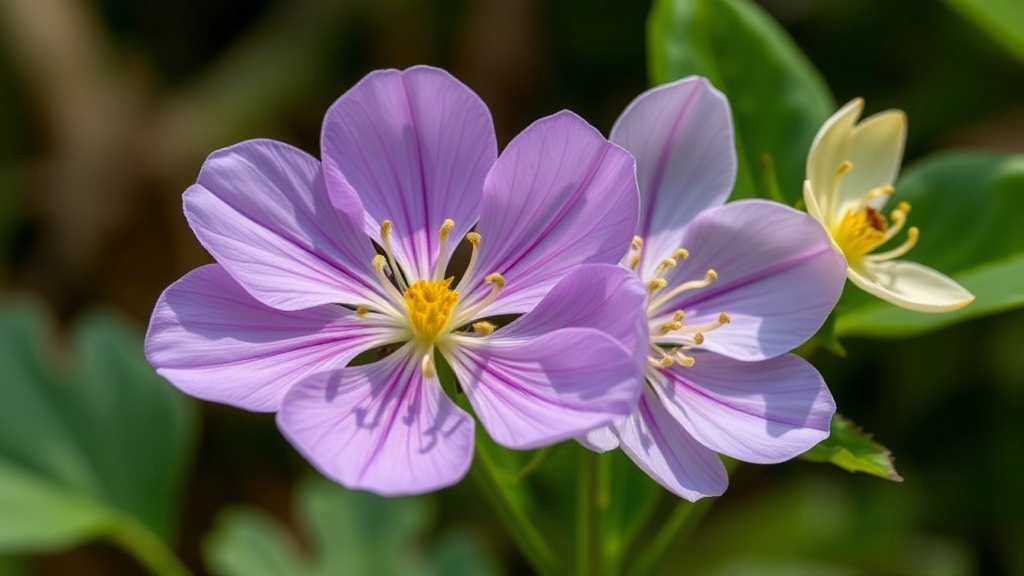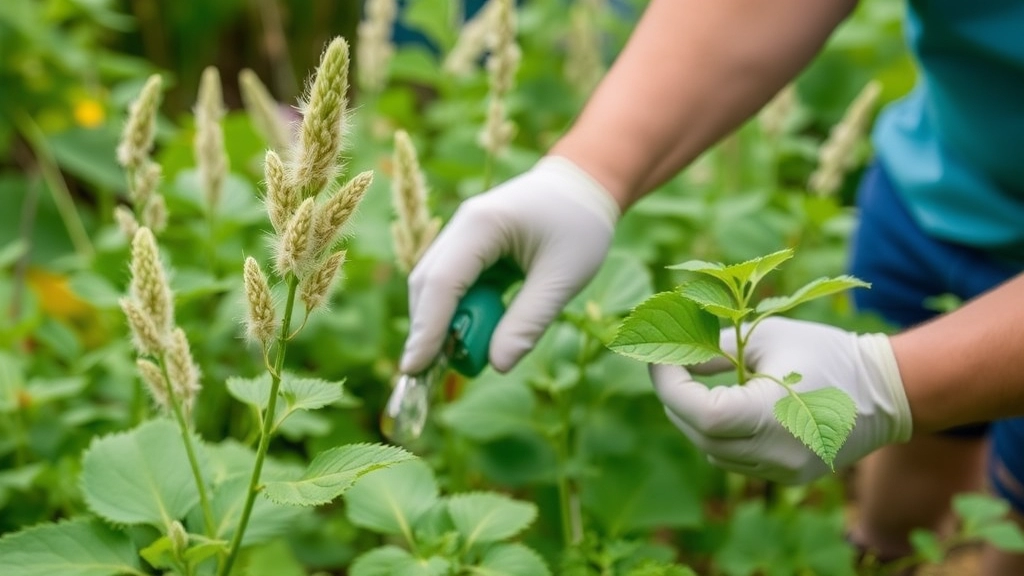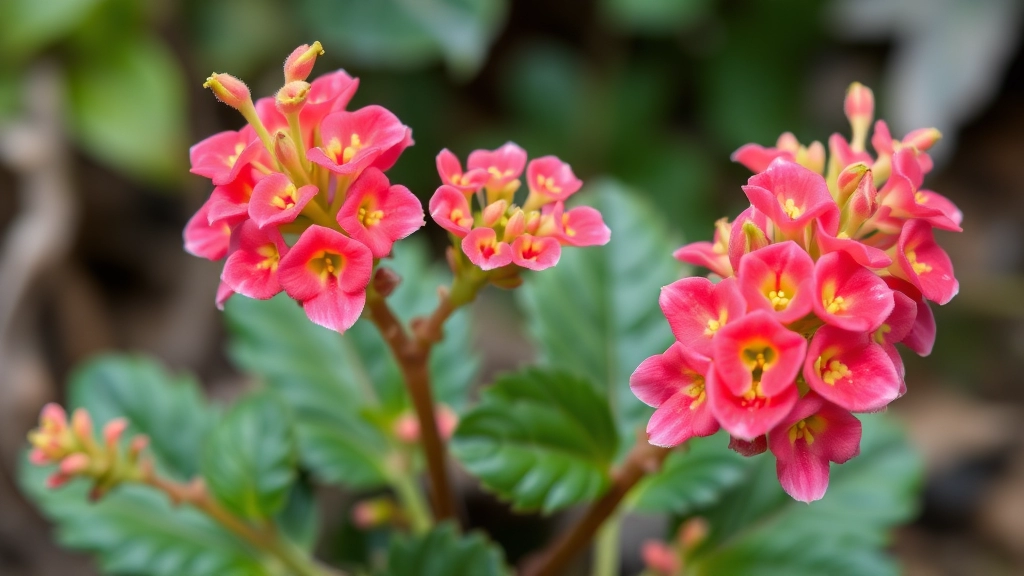Kalanchoe Mother of Thousands Care Guide
When it comes to the Kalanchoe Mother of Thousands flower, understanding its unique needs can make all the difference in your plant care journey. This fascinating succulent, known for its prolific plantlets, thrives with the right balance of light, temperature, and soil. Let’s dive into how you can create the perfect environment for your Mother of Thousands to flourish.
Watering Requirements
One of the key aspects of caring for the Kalanchoe Mother of Thousands flower is managing its watering requirements. This plant prefers well-draining soil and should be watered sparingly to prevent root rot. Additionally, while it seldom flowers, knowing how to encourage blooming and understanding its rare flowering process can add to the joy of growing this unique plant.
Additional Tips
Keep reading to explore more tips on propagating its plantlets and ensuring your Mother of Thousands stays healthy year-round.
Growing Conditions for Mother of Thousands
Are you struggling to create the perfect environment for your Mother of Thousands? You’re not alone. Many plant enthusiasts find it challenging to replicate the ideal conditions for this unique succulent.
To thrive, Mother of Thousands (Kalanchoe daigremontiana) requires specific growing conditions that mimic its native habitat. Here’s what you need to know:
Light Requirements
- Bright Indirect Light: This plant flourishes in bright, indirect sunlight. Direct sun can scorch its leaves.
- Adaptability: It can tolerate lower light conditions but may not grow as vigorously.
Temperature Preferences
- Warm Temperatures: Ideally, keep your Mother of Thousands in temperatures between 20°C to 30°C (68°F to 86°F). For more details on optimal temperature ranges, you can refer to the Ideal Temperature for Kalanchoe Blossfeldiana Growth.
- Avoid Cold Drafts: Sudden temperature drops below 10°C (50°F) can stress the plant.
Humidity Levels
- Low Humidity: This succulent prefers a dry environment. High humidity can lead to rot.
- Air Circulation: Ensure good air circulation around the plant to prevent fungal issues. For more tips on maintaining healthy growth, check out our Top Health Benefits of Kalanchoe Mother of Thousands.
Light and Temperature Needs

So, you’ve got your Mother of Thousands and you’re wondering how to keep her thriving?
Light and temperature are crucial for her well-being.
Light Requirements
- Bright, Indirect Light: Mother of Thousands loves bright, indirect sunlight.
- Avoid Direct Sun: Too much direct sunlight can scorch those lovely leaves.
- Indoor vs. Outdoor: If you’re keeping her indoors, a south or west-facing window is ideal. Outdoors, dappled sunlight works wonders.
Temperature Preferences
- Warm Temperatures: She prefers temperatures between 20°C to 30°C (68°F to 86°F).
- Avoid Cold Drafts: Keep her away from chilly drafts or sudden temperature drops.
- Winter Care: In winter, she can tolerate cooler temperatures, but aim to keep it above 10°C (50°F).
Quick Tips
- Check the Weather: If it’s too hot or too cold outside, consider moving her indoors temporarily.
- Rotate Your Plant: To ensure even growth, rotate your Mother of Thousands every couple of weeks.
Ideal Soil for Healthy Growth
When it comes to nurturing your Mother of Thousands, the right soil can make all the difference.
Are you worried about your plant thriving in the wrong soil mix?
Choosing the ideal soil is essential for promoting healthy growth and ensuring your plant’s longevity.
Soil Composition
- Well-Draining Soil: Mother of Thousands prefers a soil mix that drains well. This prevents root rot, a common issue with overwatering.
- Cactus or Succulent Mix: A commercial cactus or succulent mix is often the best choice. These mixes are specifically designed to provide the right drainage and aeration.
- DIY Soil Mix: If you prefer to create your own, combine:
- 50% potting soil
- 25% coarse sand
- 25% perlite or pumice
pH Level
Aim for a slightly acidic to neutral pH, ideally between 6.0 and 7.0. This range allows your plant to absorb nutrients effectively.
Nutrient-Rich Additives
While Mother of Thousands doesn’t require overly rich soil, adding a small amount of organic matter can be beneficial. Consider mixing in:
- Compost
- Well-rotted manure
These additives provide essential nutrients without overwhelming the plant.
Container Choice
Ensure your pot has drainage holes. This is crucial for preventing water accumulation and promoting healthy root growth.
For more detailed care tips, you might find our Mother of Thousands Complete Care and Propagation Guide helpful. Additionally, if you’re interested in learning about other Kalanchoe varieties, our guide to Kalanchoe succulent plants is a great resource.
Watering Requirements and Techniques

When it comes to caring for your Mother of Thousands, understanding its watering needs is essential for promoting healthy growth. Many plant enthusiasts often worry about overwatering or underwatering their succulents.
Watering Guidelines
- Frequency: Water your Mother of Thousands every 2-3 weeks during the growing season (spring and summer). In the winter, reduce this to once a month or less, as the plant enters dormancy.
- Soil Check: Always check the soil moisture before watering. Insert your finger about an inch into the soil; if it feels dry, it’s time to water. If it’s still moist, wait a few more days.
- Method: Use the “soak and dry” method. Water thoroughly until you see excess water draining from the bottom of the pot. Allow the soil to dry out completely before the next watering.
- Container Considerations: Ensure your pot has drainage holes. This is crucial to prevent water from sitting at the bottom, which can lead to root rot.
Tips for Optimal Watering
- Time of Day: Water in the morning to allow any excess moisture to evaporate during the day. This helps prevent fungal issues.
- Water Quality: Use room temperature water. Cold water can shock the plant, while distilled or rainwater is ideal for optimal growth.
- Signs of Overwatering: Yellowing leaves or mushy stems indicate too much water. If you notice these signs, reduce your watering frequency immediately.
- Signs of Underwatering: If the leaves appear shriveled or are dropping, it’s time to give your Mother of Thousands a good soak.
To encourage flowering in your Mother of Thousands, it’s essential to understand its specific needs. For comprehensive care and propagation tips, you might find this [guide on how to propagate Kalanchoe Mother of Thousands](https://planthq.org/how-to-propagate-kalanchoe-mother-of-thousands-easily/) particularly useful.
Enhancing the flowering potential of your plant involves several strategies, including nutrient balance and pruning. For more detailed information on care techniques, consider checking out this [complete care guide for Kalanchoe Mother of Thousands](https://planthq.org/kalanchoe-mother-of-thousands-care-propagation-and-flowering/).
Understanding the Rare Flowering Process

Ever wondered why your Mother of Thousands seems more focused on growing those charming little plantlets rather than blooming? You’re not alone. Many plant enthusiasts share this curiosity.
Why Flowering is Rare
Flowering in Mother of Thousands (Kalanchoe daigremontiana) is a bit of a rarity. This succulent is known for its ability to produce offsets, or plantlets, which are its primary means of reproduction. Here’s the scoop on why flowering doesn’t happen often:
- Energy Focus: The plant directs its energy into producing those adorable babies instead of flowers.
- Environmental Triggers: Certain conditions need to align for flowering to occur. This includes optimal light, temperature, and even stress factors.
- Age of the Plant: Younger plants are less likely to flower. It typically takes a few years before they even think about it.
Encouraging Flowering
If you’re keen to see those blooms, there are ways to encourage flowering:
- Stress the Plant: A little stress can help! Reducing water or slightly changing its environment can sometimes trigger flowering.
- Provide Bright Light: Ensure your plant is basking in plenty of bright, indirect sunlight. This can help stimulate the blooming process.
- Temperature Control: Keeping your plant in a warm environment, ideally between 20-25°C, can also help.
The Flowering Cycle
When your Mother of Thousands finally decides to bloom, it’s quite the sight. The flowers are usually small and tubular, often in shades of yellow or orange.
- Timing: Flowering typically occurs in late winter to early spring, so keep an eye out during this period.
- Duration: The blooms don’t last long, usually a few weeks, but they’re worth the wait!
VII. Propagating Mother of Thousands: Using Plantlets
Have you ever wondered how to grow more Mother of Thousands from your existing plant?
This remarkable succulent is not just a beauty; it’s also a prolific producer of plantlets, making propagation straightforward and rewarding.
Understanding Plantlets
The Mother of Thousands (Kalanchoe daigremontiana) produces small plantlets along the edges of its leaves. These tiny plants can easily take root and grow into new, independent specimens.
Steps for Successful Propagation
- Select Healthy Leaves
Choose mature leaves that are free from pests or disease. Healthy leaves yield the best plantlets. - Remove the Leaf
Gently twist or cut the leaf from the main plant, ensuring you don’t damage the stem. - Let It Callous
Place the leaf in a dry, shaded area for a few days. This allows the cut end to callous over, reducing the risk of rot. - Prepare the Soil
Use a well-draining soil mix, such as a cactus or succulent blend, to promote healthy root development. - Plant the Leaf
Lay the leaf flat on the soil surface. The plantlets will begin to sprout from the edges. - Water Sparingly
Mist the soil lightly to keep it slightly damp but not soggy. Overwatering can lead to rot. - Provide Adequate Light
Place the container in a bright, indirect light location. Too much direct sunlight can scorch the leaves.
Watching Them Grow
In a few weeks, you’ll notice tiny plantlets forming. As they grow, you can gently transplant them into their own pots. For more detailed tips on care and propagation, check out our comprehensive guide on Kalanchoe Mother of Thousands.
- Timing: Spring is the best time for propagation as the plant is actively growing.
- Success Rate: Using this method, you can expect a high success rate with minimal effort.
For those interested in exploring other Kalanchoe varieties, our guide to top Kalanchoe succulent varieties offers valuable insights and care tips.
Preventing Invasive Growth Outdoors

So, you’ve got a thriving Mother of Thousands, and now you’re wondering, “How do I keep this beauty from taking over my garden?” Trust me, you’re not alone in this concern. This plant is known for its ability to spread like wildfire if left unchecked, so let’s dive into some practical tips to keep it in check.
Understanding the Risks
Mother of Thousands (Kalanchoe daigremontiana) can be a bit of a garden rebel. It produces tiny plantlets that can easily root in the soil, leading to rapid growth. Here’s how to manage that:
- Choose the Right Location:
- Plant it in an area where it can’t easily spread to other parts of your garden.
- Consider containers or raised beds to contain its growth.
- Regular Maintenance:
- Regularly check for any rogue plantlets that may have dropped.
- Remove them promptly to prevent new plants from establishing.
- Mulching:
- Use mulch around the base to suppress new growth.
- This also helps retain moisture, which is a win-win!
- Limit Seed Production:
- If your plant flowers, it can produce seeds.
- Pinch off flower stalks before they go to seed.
Control Measures
If you find that your Mother of Thousands is getting a bit too ambitious, here are some control measures:
- Physical Barriers:
- Use garden fabric or plastic barriers around the plant to prevent spread.
- Regular Pruning:
- Keep it trimmed back to manage its size and prevent it from going wild.
- Monitor Surrounding Plants:
- Keep an eye on neighbouring plants. If they start to show signs of invasion, act quickly.
As we explore the care of Mother of Thousands, it’s essential to address common issues that can arise during its growth.
### Pests
Mother of Thousands can attract various pests, which may hinder its growth. Here are the most common culprits:
– **Mealybugs**: These small, white insects can cluster on leaves and stems. They suck the plant’s sap, leading to wilting.
– **Aphids**: Often found on new growth, these tiny green pests can cause distortion and yellowing of leaves.
– **Spider Mites**: These arachnids thrive in dry conditions, leading to stippling on leaves and webbing.
**Prevention and Treatment**:
– Regularly inspect your plant for signs of pests.
– Use insecticidal soap or neem oil to treat infestations.
– Keep the plant clean by gently wiping leaves with a damp cloth.
### Rot
Root rot is another significant concern, often caused by overwatering or poor drainage. Here’s how to identify and prevent it:
– **Signs of Root Rot**:
– Yellowing leaves
– Wilting despite adequate moisture
– A foul smell from the soil
**Prevention and Treatment**:
– Ensure your pot has drainage holes.
– Use well-draining soil to avoid water accumulation.
– Allow the soil to dry out between waterings.
### Fungal Issues
Fungal infections can also affect Mother of Thousands, particularly in humid conditions.
– **Common Fungal Problems**:
– **Powdery Mildew**: A white, powdery substance on leaves, often due to poor air circulation.
– **Leaf Spot**: Dark spots that can lead to leaf drop.
**Prevention and Treatment**:
– Ensure good air circulation around the plant.
– Remove affected leaves promptly.
– Use a fungicide if necessary.
For more tips on caring for this unique plant, check out our [complete guide to growing Kalanchoe Mother of Thousands](https://planthq.org/complete-guide-to-growing-kalanchoe-mother-of-thousands/). Additionally, if you’re facing issues with propagation, our article on [how to propagate Kalanchoe Mother of Thousands easily](https://planthq.org/how-to-propagate-kalanchoe-mother-of-thousands-easily/) might help.
Fertilization for Optimal Growth

Are you wondering how to keep your Mother of Thousands thriving?
Proper fertilization is key to ensuring this unique succulent reaches its full potential.
When to Fertilize
- Growing Season: The best time to fertilize is during the spring and summer months.
- Frequency: Aim for every 4-6 weeks.
What to Use
- Balanced Fertilizer: A diluted, balanced liquid fertilizer (like 10-10-10) works wonders.
- Organic Options: If you prefer organic, consider using fish emulsion or a cactus-specific fertilizer.
How to Apply
- Dilute: Always dilute your fertilizer to half the recommended strength.
- Water First: Water your plant a day before applying fertilizer. This helps prevent root burn.
- Even Distribution: Pour the diluted mix evenly around the base of the plant.
Signs of Over-Fertilization
Keep an eye out for:
- Brown Leaf Tips: This could indicate too much fertilizer.
- Stunted Growth: If your plant isn’t growing, it may be overwhelmed.
Tips for Success
- Skip Winter: Don’t fertilize during the dormant winter months.
- Observe: Every plant is different, so adjust based on how your Mother of Thousands responds.
Repotting and Container Care for Mother of Thousands
Have you noticed your Mother of Thousands becoming root-bound or outgrowing its pot? Repotting is essential for maintaining its health and vitality.
Seasonal Care: Winter Dormancy and Maintenance for Mother of Thousands
As the chill of winter approaches, you might be wondering how to keep your Mother of Thousands thriving. These unique plants have specific needs during this dormant period, and understanding them can make all the difference.
What to Expect in Winter
During winter, Mother of Thousands tends to slow down. This is completely normal, and it’s essential to adjust your care routine accordingly. Here’s what you need to know:
- Light Requirements: Ensure your plant still gets plenty of indirect sunlight. If natural light is scarce, consider using a grow light.
- Temperature: Keep your plant in a warm spot, ideally between 10°C and 21°C. Avoid cold drafts, as they can stress your plant.
Watering Tips
Overwatering is a common mistake in winter. Here’s how to avoid it:
- Check the Soil: Before watering, poke your finger into the soil. If it feels dry an inch down, it’s time to water.
- Reduce Frequency: Water less frequently, perhaps every 2-3 weeks, depending on your home’s humidity.
Fertilization During Dormancy
During this period, your Mother of Thousands doesn’t need much food. Here’s a simple guideline:
- Skip Fertilizer: Hold off on fertilizing until spring. This allows the plant to rest and recharge.
Keep an Eye Out
Even though your plant is dormant, it’s still important to check for any issues:
- Pests: Look out for common pests like mealybugs or aphids. A quick wipe with a damp cloth can help keep them at bay.
- Rot: Ensure that the soil drains well. If you notice any mushy leaves, it might be a sign of rot.
For more detailed guidance on propagation, check out our Kalanchoe Mother of Thousands Propagation Guide. Additionally, if you’re interested in exploring other varieties, you might find our Comprehensive Kalanchoe Species List for Gardeners quite helpful.
FAQs about Kalanchoe Mother of Thousands Flower
What are the light requirements for Mother of Thousands?
Mother of Thousands thrives in bright, indirect sunlight. Avoid exposing the plant to direct sun as it can scorch the leaves. For indoor growth, a south or west-facing window is ideal, while dappled sunlight works well for outdoor settings.
What temperature range is best for Mother of Thousands?
This plant prefers warm temperatures between 20°C to 30°C (68°F to 86°F). During winter, it can tolerate cooler temperatures but should be kept above 10°C (50°F) to avoid damage.
How often should I water my Mother of Thousands?
Watering frequency depends on the season. During the growing season (spring and summer), water every 2-3 weeks. In winter, reduce watering to once a month or less. Always check the soil moisture before watering and use the “soak and dry” method.
Why doesn’t my Mother of Thousands flower often?
Flowering in Mother of Thousands is rare because the plant primarily focuses its energy on producing offsets or plantlets. Environmental triggers, plant age, and stress factors can influence the flowering process.
How can I encourage my Mother of Thousands to flower?
To encourage flowering, you can stress the plant slightly by reducing water or changing its environment. Providing bright, indirect light and maintaining a warm temperature between 20-25°C can also help stimulate blooming.
How can I prevent my Mother of Thousands from becoming invasive outdoors?
To prevent invasive growth, plant it in a controlled area such as containers or raised beds. Regularly check for and remove rogue plantlets, use mulch to suppress new growth, and pinch off flower stalks before they go to seed.
What are the best practices for fertilizing Mother of Thousands?
Fertilize during the growing season (spring and summer) every 4-6 weeks using a diluted, balanced liquid fertilizer (like 10-10-10) or organic options like fish emulsion. Always dilute the fertilizer to half the recommended strength and water the plant a day before applying to prevent root burn.
What are the signs of over-fertilization in Mother of Thousands?
Signs of over-fertilization include brown leaf tips and stunted growth. If you notice these symptoms, reduce the frequency and strength of your fertilization.
Should I fertilize my Mother of Thousands during winter?
No, it’s best to skip fertilizing during the dormant winter months. Resume fertilization in the spring when the plant starts actively growing again.
How can I ensure even growth for my Mother of Thousands?
Rotate your plant every couple of weeks to ensure even growth. This helps all sides of the plant receive adequate light and prevents it from leaning towards one direction.
References
-
Mother of Thousands Plant Profile – The Spruce
-
Mother of Thousands Care – Gardening Know How
-
Mother of Thousands – House Plants Expert
